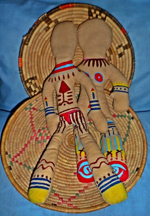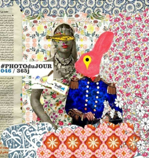Thanks to its focus on West Africans telling the stories of West Africa and its well-thought out multi-dimensional delivery, the ‘West Africa: word, symbol, song’ exhibition at the British Library is powerfully insightful and approachable to all, from academic specialists to children and reluctant museum-goers. Camille Jacob took part in the curator-led tour with Dr Janet Topp Fargion and explains more about the event.
The exhibition “West Africa: word, symbol, song” at the British Library explores 1000 years of West African history(ies) through over 200 objects, including books, manuscripts, songs, videos, musical instruments, artworks, masks and textiles. This event aims to question the stereotype of an African continent made of a clash between oral traditions and imposed Western values by showcasing the long intellectual tradition of the region through the breadth and wealth of literature and graphic/symbolic systems as well as the complexity of oral literature. The organisation of the exhibition (five loose spaces, generally chronological) is closer in style to the Musée du Quai Branly’s thematic approach than other traditional institutions’ focus on colonial boundaries. Even though it is very immersive (with music through speakers, headphones, in “pods”), this is not a systematic overview of West African history or state-building (nor does it claim to be). It feels more like an exciting exploration of the diverse ways in which words, symbols and songs have been used by men and women to create, adapt and live forms of tradition and protest.
The main strength of this exhibition is the focus on having the stories and symbols of West Africa told by West Africans themselves rather than through a European lens. This is not always possible (for example some of the ethnographic recordings), but it does a fantastic job of not depriving the main actors of their voices. Books (Bibles, pamphlets, autobiographies), drawings, clothing created by West Africans give us glimpses of the encounter with missionaries and the slave trade. In doing so the curators avoid the pitfall of telling the horrific story of slavery only through the abolitionist movement, as discussed in more detail in this excellent article by Joel Quirk for Open Democracy. The idea of tradition as something which is written, spoken, re-created, re-appropriated and sometimes re-invented is also a huge part of this thematic focus, from the drums on display being borrowed from a South London ensemble who normally use them for concerts and work in schools, to the Notting Hill carnival bele dress bringing together African, Caribbean and European influences. Women’s voices are not silenced either, from religious traditions to music and literature. Songs, symbols and words cross from West Africa to the Caribbean, to America, back to West Africa, to Europe.
This idea of crossings links to another hidden highlight of the exhibition. The usual distinction between Anglophone and Francophone countries of the region is simply not used. While not completely irrelevant, it is very clear that over the thousand years of history it tries to portray, these categories would be not only extremely Euro-centric but actually utterly meaningless for four fifths of the period, in the same way as colonial boundaries do not play a role until much later. The colonial language starts to have a noticeable impact in the last two spaces, entitled “speaking out” and “story now”, which explore how words, symbols and music were used to raise issues and fight injustice, and the many ways in which these stories are remembered, told, created and re-created. In other words, one notices that a book might be written in French or in English, or that a president spent some his formative years in Paris or London, or uses links with Paris-based artists. But the spotlight is on the underlying themes and use of symbols, from the recreating African cultures (such as the Vai scripts in Liberia) to adopting and adapting new cultural forms.
‘West Africa: word, symbold song’ is at the British Library until 16 February 2016. More information here.






